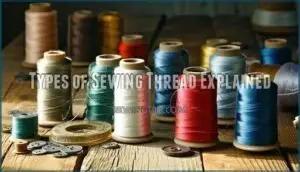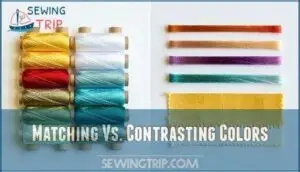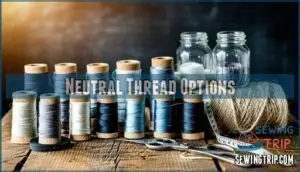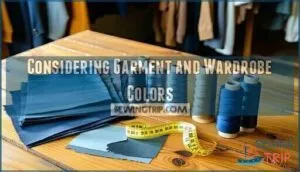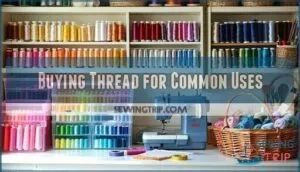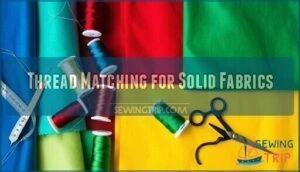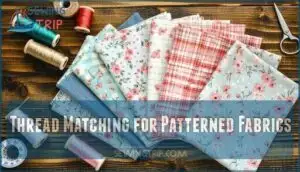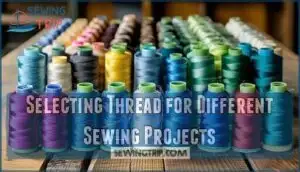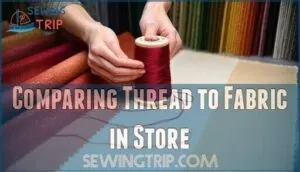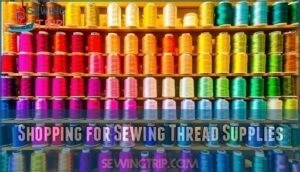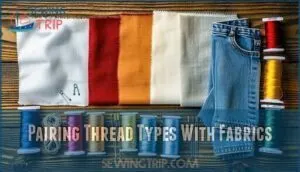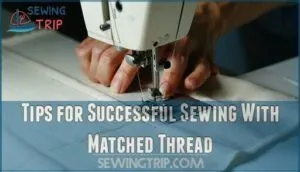This site is supported by our readers. We may earn a commission, at no cost to you, if you purchase through links.
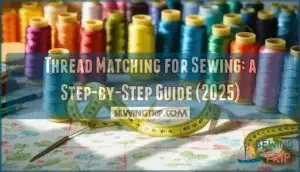 Thread matching for sewing is part science, part art—matching thread to fabric brings your project together like a puzzle with no missing pieces. Start by choosing thread close in color and fiber to your fabric; when in doubt, go slightly darker for a polished seam.
Thread matching for sewing is part science, part art—matching thread to fabric brings your project together like a puzzle with no missing pieces. Start by choosing thread close in color and fiber to your fabric; when in doubt, go slightly darker for a polished seam.
Cotton thread works well for natural fabrics, while polyester shines with synthetics.
Don’t sweat the small stuff: lighting can fool your eyes, so always check your thread in daylight if you can. The right match blends your stitches into the fold, leaving your work looking sharp from any angle—just wait until you see the tricks for prints.
Table Of Contents
- Key Takeaways
- What is Thread in Sewing?
- Types of Sewing Thread Explained
- How to Choose Thread Colors
- Thread Matching for Solid Fabrics
- Thread Matching for Patterned Fabrics
- Selecting Thread for Different Sewing Projects
- Step-by-Step Thread Matching Process
- Shopping for Sewing Thread Supplies
- Pairing Thread Types With Fabrics
- Tips for Successful Sewing With Matched Thread
- Frequently Asked Questions (FAQs)
- Conclusion
Key Takeaways
- Choose thread that closely matches your fabric’s color and fiber, leaning slightly darker if unsure, for seams that blend in cleanly. – Specialty threads, like elastic, invisible, or waxed, suit specific tasks and can improve results with tricky fabrics or detailed techniques. – Evaluate thread and fabric together under natural light, as lighting dramatically affects color perception and final appearance. – Pair thread weight and composition with your fabric type, and prioritize functional blending or intentional contrast to achieve your desired finish.
What is Thread in Sewing?
Thread, in sewing, is a slender strand made from fibers like cotton or polyester, used to join pieces of fabric together.
While the word shows up in lots of contexts, here it simply means the essential link that holds your projects tight and secure.
Definition and Meaning of Thread
When you hear the word “thread,” do you picture a tiny lifeline that holds everything together? At its heart, thread is a slender strand spun from fibers, designed for sewing and joining fabric.
Beyond the sewing box, its definition and meaning stretch into metaphors—the “thread” that binds ideas, weaves stories, or connects events, including:
- Textile strands in fabric
- Metaphorical threads of thought
- Thread etymology—Old English origins
- Delicate sewing filaments
Thread in Textile Vs. Other Contexts
Ever noticed how one little word—“thread”—can weave its way through language just as easily as it runs through the eye of a needle? In sewing, thread is a strand of textile fibers, spun and twisted for strength and precision.
Beyond fabric, “thread” stretches—digitally and metaphorically—connecting ideas, conversations, and histories. That’s the beauty of its semantic range and thread evolution.
Parts of Speech and Word History
Pulling on the thread of language reveals just how far this humble word stretches, both in function and in time. Etymology Explored, “thread” comes from Old English and Germanic roots, weaving through history as both noun and verb. Its Grammatical Roles tell a story of Semantic Evolution:
- A strand in textiles
- A line of thought
- A screw’s spiral
- A continued narrative
Example Sentences and Usages
After tracing the roots of the word “thread,” it’s worth seeing how it weaves into everyday conversation and daily sewing.
For example, you might hear: “Don’t lose the thread of the story,” or, during a sewing project, “Find a thread match for this fabric.” These phrases show how thread metaphors and figurative language stitch storytelling and technique together.
Types of Sewing Thread Explained
Choosing the right sewing thread is about understanding fiber types, specialty options, and how each performs for your project.
Let’s break down the main categories you’ll see at any well-stocked sewing aisle and what makes them unique.
Cotton, Polyester, Nylon, and Rayon Threads
Once you know what thread is, the next step is understanding the fibers behind the names—cotton, polyester, nylon, and rayon each bring their own personality to your sewing projects.
Cotton thread feels soft but may lack the thread strength of polyester. Polyester thread stands out for durability and cost comparison, while rayon and nylon add sheen and flexibility.
Each fiber influences thread selection, blending threads, and even sustainability impact in your work.
Specialty Threads (Elastic, Invisible, Waxed)
If you’ve ever wondered how stitches can disappear, gather fabric with a gentle tug, or glide through leather without a hitch, specialty threads make all that magic happen.
- Elastic sewing thread cinches fabric—great for shirring and cuffs. – Invisible thread blends seamlessly for discreet seams; it’s ideal for tricky fabric combinations. – Waxed thread durability shines in leathercraft, thanks to its tangle-free strength.
Topstitching and Upholstery Threads
Just like specialty threads each bring their own quirks to the table, topstitching and upholstery threads step in when your sewing project needs extra strength or bold detail.
Topstitching weight stands out for decorative stitching—think visible jeans hems—while upholstery durability keeps stitches secure in heavy fabrics or leather.
Gutermann Topstitch Thread and Gutermann Upholstery Thread are reliable choices for these demanding upholstery projects.
Thread Fiber Characteristics
Thread fiber characteristics aren’t just technical buzzwords—they’re the backbone of how your stitches perform. Consider tensile strength for seams that hold, moisture absorption if your fabric fiber wicks sweat, and elasticity or elongation when sewing knits.
Abrasion resistance matters for frequent wear, while fiber finish, like mercerized cotton thread, influences luster and color. Each quality shapes your sewing outcomes.
How to Choose Thread Colors
Choosing the right thread color can make or break the look of your sewing project. Whether you want your stitching to blend in or stand out, knowing what to look for helps you get professional results every time.
Matching Vs. Contrasting Colors
Most days, the thread color you choose shapes the final look and feel of your project. Seam Blending with matched thread quietly fades into the fabric, reducing Stitch Visibility and keeping things polished. Going bold with contrasting thread highlights seams, turning stitches into part of the design.
Each choice influences Aesthetic Impact and Color Perception, transforming simple sewing into intentional style. Matching thread fiber to fabric fiber is recommended when possible, so consider your thread choice.
Neutral Thread Options
When you want a thread that quietly works with almost anything in your stash, neutrals are your best secret weapon. Stock up on gray scale, beige tones, navy blends, and black shades; these blending neutrals tackle color matching for nearly any solid color or print.
A gray thread match often disappears into seams, giving you flexibility without fuss.
Considering Garment and Wardrobe Colors
Take a quick look at what fills your closet, and you’ll start to see which thread shades will really earn their keep. If your go-to pieces center around blues, grays, or earth tones, focus on coordinating thread hues within that wardrobe color palette.
This simple garment color analysis helps narrow your options for capsule wardrobe threads and promotes smoother color matching across seasonal color trends.
Buying Thread for Common Uses
Think of your thread stash as a toolbox—stocking up on the right basics now means smoother sewing for almost any project down the line.
Prioritize adaptable sewing thread colors and spool sizes that fit your most frequent project needs.
Weigh thread storage, budgeting thread for bulk buys, and thread lifespan against your brand loyalty. Smart choices now aid quick thread match solutions later.
Thread Matching for Solid Fabrics
Choosing the right thread color for solid fabrics can make the difference between a professional-looking finish and a distracting seam.
With just a few practical guidelines, you’ll always find a match that blends in smoothly and looks polished.
Finding The Closest Color Match
Anyone learning thread matching techniques knows that selecting thread colors is rarely about an exact swatch comparison. Value matching—choosing a thread just slightly darker—usually leads to better blending strategies.
Lighting evaluation is essential, as fabric and thread pairing may look different under sunlight versus a lamp. Today, digital tools make easier color selection, but in-person matches still hold unique accuracy.
You must heed thread visibility factors for professional-looking seams.
Tips for Blending Thread With Fabric
Ever wonder how a well-chosen thread can melt right into your fabric, almost disappearing before your eyes? Start by holding potential threads against your fabric under natural light. Pay close attention to color undertones and fabric texture.
For best results, use blending techniques that minimize stitch visibility—subtle differences matter! Smart thread matching techniques improve any sewing project and guarantee a polished finish.
When to Choose Darker or Lighter Threads
Imagine this: you’re holding up two spools, one darker and one lighter, and it’s the shadow play between them that decides if your stitches disappear or stand out.
Darker thread colors usually mask shadowing imperfections and blend best with deeper fabric colors. Lighter threads catch more light, highlighting intentional contrast or enhancing sheen—a subtle trick for showcasing thread depth or achieving color illusion.
Thread Matching for Patterned Fabrics
Choosing thread for patterned fabrics can feel like trying to find the quietest voice in a crowded room—your goal is to blend, not stand out.
We’ll walk through practical ways to pick thread that complements busy prints and multicolored designs.
Picking Thread for Multicolored Prints
Choosing a thread color for patterned fabrics isn’t about finding a perfect match—it’s about merging with the print’s mood. You’ll often get the most harmonious result by:
- Eyeing the Dominant Color for easy blending.
- Selecting a Neutral Blending thread like medium gray.
- Testing Darkest Matching or Variegated Options, using Elimination Testing to narrow choices.
Good fabric, good color selection, simple results.
Blending Thread With Busy Patterns
Amid a flurry of colors and shapes, finding the right thread can feel a bit like sneaking in quietly so your stitches don’t shout over the pattern.
Try focusing on the background color or the most consistent hue—what’s sometimes called Print Dominance.
Matching thread to patterned fabric is easier when you stick within similar color families and rely on midweight threads for even blending strategies, regardless of pattern scale.
Selecting Thread for Different Sewing Projects
Matching thread to the demands of each sewing project—whether it’s stitching up clothing, tackling upholstery, or adding decorative detail—sets the tone for the finished look.
Your thread choice can make seams disappear, highlight a design, or add strength where it’s needed most.
Clothing Construction and Alterations
Every well-made piece of clothing starts with the right thread, picking up where fabric leaves off and holding all the details together. Whether you’re reinforcing a seam, handling hem adjustments, or troubleshooting fitting issues, an accurate thread match can make a difference.
From button attachment to zipper replacement, sewing thread choice quietly bolsters the durability and finish of your clothing items.
Decorative Topstitching and Embellishments
Once you’ve got your main seams looking sharp, it’s the details like decorative topstitching and embellishments that give your handmade pieces their signature flair. Think about:
- Choosing thread colors or color contrast for eye-catching borders.
- Using heavier topstitching thread for crisp definition.
- Exploring stitch patterns for texture.
- Matching needle size to thread weight.
- Adjusting tension settings for smooth, even decorative stitching.
Quilting, Upholstery, and Home Décor
After finishing up with topstitching details, it’s time to talk about the kinds of thread you’ll want for quilting, upholstery, and those home projects that make a house feel personal. The choice comes down to thread characteristics—like strength, sheen, and weight—plus stitch visibility, fabric density, and décor blending.
| Use | Thread Type | Why It’s a Match |
|---|---|---|
| Quilting | Quilting Threads | Blends, minimizes breakage |
| Upholstery | Upholstery Weight | Works with heavy fabric density |
| Décor | All-purpose | Invisible seams, soft finish |
Step-by-Step Thread Matching Process
Matching thread to fabric is a hands-on process that starts at the store and often depends on subtle differences in color and light.
Knowing how to assess thread choices in real-world conditions ensures your finished project looks unified and polished.
Comparing Thread to Fabric in Store
There’s a certain thrill in holding spools up against your fabric, chasing that satisfying moment when color and texture just click.
In-store, you’ll want to:
- Compare spools directly to fabric swatches for a true thread match
- Factor in fabric texture—how does the thread sit against the weave? – Remember store limitations: lighting considerations and color perception can shift, so trust your eye and prioritize a close match when selecting thread color.
Evaluating Matches in Different Lighting
Light can turn a perfect color match in-store into a surprise at home, so have you ever noticed how a shade shifts as you step from aisle to sunlight? The light temperature and type—Indoor Illumination, Outdoor Sunlight, or Artificial Lighting—can dramatically alter color perception. Always check your thread match in several settings before selecting thread color for a harmonious color palette.
| Lighting Type | How It Affects Color | Sewing Project Tips |
|---|---|---|
| Indoor Illumination | Soft, warmer hues | Hold fabrics near a window if possible. |
| Outdoor Sunlight | Shows true color | Step outside to confirm the best match. |
| Artificial Lighting | Can distort undertones | Use a daylight bulb for evening sewing. |
| Mixed Environments | Unpredictable shifts | Preview your choices in multiple locations. |
Shopping for Sewing Thread Supplies
When purchasing sewing thread, your choices—where and how much you buy—shape the ease and flexibility of your projects.
Building a collection of all-purpose spools ensures you’re ready for any fabric that comes your way.
Buying Thread Online Vs. In-Store
You’ve compared samples and found your match—now comes the choice between clicking “add to cart” or heading out to see spools in person. Consider these:
- Online color accuracy can be tricky—screen settings may distort hues.
- In-person texture helps confirm thread weight and finish.
- Spool size availability, shipping costs, and return policies all impact your final decision.
Choosing Spool Sizes and Quantities
A little planning goes a long way when you’re stocking up on thread, especially if you don’t want to run out right in the middle of a project. Consider your sewing thread usage frequency—grab larger spools for workhorse colors, or try starter thread kits for variety. For tight budgets or bulk thread savings, smaller spools help stretch your shopping for sewing supplies.
:
————
:
——————
:
———————–
Building a Versatile Thread Collection
When you start pulling together your own stash of thread, it’s a bit like setting yourself up with the right tools for any project that comes your way. Focus on a neutral thread palette, invest in essential spool sizes, and look for budget-friendly thread options.
Good thread storage solutions and a project-based thread buying habit make matching thread to fabric much easier.
Pairing Thread Types With Fabrics
Picking the right thread for your fabric isn’t just about choosing the perfect color. You also need to think about the fabric’s fiber, how thick the thread is, and the way you plan to sew.
Let’s break down how to pair natural and synthetic threads, adjust weight to fabric thickness, and select threads for machine or hand stitching.
Natural Vs. Synthetic Thread Choices
Now that you’ve got a sense of what to look for when stocking up on thread, let’s talk about whether natural or synthetic options make a better match for your next project.
Thread composition matters: cotton thread is beloved for tradition, but synthetic sewing thread—like Gutermann SewAll or Coats and Clark XP—offers better strength, durability, and often lower environmental impact.
Cost analysis and performance comparison usually tip in favor of synthetics for everyday sewing, with natural fibers shining in heirloom projects or specific weaving needs. Take a moment to weigh which fits best for your application.
Matching Thread Weight to Fabric Weight
Choosing the right thread can make or break your sewing project. Start by matching your thread to the fabric’s weight—a handy guide helps here.
Heavy fabrics like canvas need thicker thread and bigger needles, while delicate, lightweight fabric pairs best with something finer.
This thread match reduces bulk, improves Seam Strength Effects, and delivers reliable Performance Quantification across sewing projects. For smooth results, consider Needle Compatibility in every decision.
Sewing Machine Vs. Hand Sewing Threads
Ever wonder why some spools fly through your sewing machine while others work best in your hand? Machine thread strength and thread lubrication make sewing machine thread ideal for fast, even stitches.
Hand thread flexibility allows you to adapt to curves and repair work. Stitch appearance, sewing speed impact, and the types of sewing thread all shift between hand sewing projects.
Tips for Successful Sewing With Matched Thread
Getting the right thread match is just the start—how you sew with it makes all the difference.
A few practical habits can help you achieve clean, secure, and nearly invisible stitches every time.
Preventing Visible Stitching Imperfections
Isn’t it frustrating when your stitching looks perfect up close, but every tiny wobble pops out against the fabric from just a few steps away? Try these five tactics:
- Adjust tension for even stitches.
- Select the right needle for your sewing thread.
- Use proper stitch length.
- Choose a matching construction thread.
- Maintain presser foot pressure and thread quality.
Managing Thread Tension and Breakage
Nothing brings your sewing to a halt faster than stubborn thread tension or a sudden snap just when you’re hitting your stride. Tension Troubleshooting starts with checking your thread quality, then rethreading the machine and adjusting settings.
Machine Maintenance, Needle Compatibility, and fixing bobbin issues are all part of the process. With the right approach, you’ll minimize thread breakage and sew confidently.
Storing and Organizing Thread for Future Projects
Once you’ve got thread tension under control, keeping your thread stash neat and easy to find can save you time and headaches the next time inspiration strikes.
Try dividing sewing thread by color or brand—Gutermann thread here, Coats and Clark XP there. Use clear bins, bobbin organizers, or wall racks for space-saving, easy inventory.
These Thread Storage Ideas prevent tangling and frustration.
Frequently Asked Questions (FAQs)
How do you match thread when sewing with knits?
Matching thread for knits calls for considering stretch percentage, seam appearance, and tension adjustments. Gutermann thread or cotton thread blends well, but for elastic waistbands or high-stretch areas, use knit thread types compatible with your needle.
Can old or vintage thread affect color matching?
Occasionally, vintage thread degradation or storage impact leads to subtle fiber color changes, which—combined with original dye lot variations—makes matching aged fabrics or a spool of thread tricky. Choosing sewing thread for old projects? Consider these points:
- Dye lots and fiber aging shift thread color.
- Storage affects thread match reliability.
- Compare sewing thread under daylight for accuracy.
What should you do if perfect thread match is unavailable?
Ever notice perfect thread match isn’t always on the table? Focus on compromise colors, blending options, or acceptable contrast. Prioritize function and try creative solutions—sometimes near-misses look intentional.
Here’s a quick guide:
| Option | Pros | Tip |
|---|---|---|
| Compromise Color | Blends subtly | Pick a shade close to the fabric’s base |
| Blending Option | Disguises stitches | Choose between lighter or darker thread |
| Acceptable Contrast | Adds visual interest | Go bold, but keep it intentional |
| Creative Solution | Unique style | Try decorative topstitch or cotton thread |
How does thread sheen impact visible color blending?
Light reflection from thread sheen can draw the eye, making even a near-perfect thread match stand out, especially on smooth fabric.
For subtle blending, match sheen to your fabric texture and thread composition for undetectable color perception.
Are there tricks for matching thread to textured fabrics?
Weaving texture into the fold, here’s a trick: pick a thread weight matching the fabric, then pull a strand across the weave.
Texture blending improves as lighting effects and fabric movement help conceal stitch visibility in your sewing project.
Conclusion
Rumor has it that “close enough” works for thread matching in sewing, but the truth is, accuracy pays off. Taking time to match thread to your fabric—considering color, weight, and fiber—really makes your projects shine.
Mastering thread matching for sewing lets your handiwork blend or pop, just as you intended. With every stitch, you gain sharper results and more creative options. Let this guide help you make every seam count, project after project.
- https://austintrim.co/the-science-of-color-in-embroidery/
- https://blog.wardrobesupplies.com/how-to-choose-sewing-thread/
- https://www.mhthread.com/blog/products/does-bobbin-thread-need-to-match-top-thread
- https://gabriellearruda.com/fabric-texture-color-personal-style/
- https://www.vogue.com/article/spring-summer-2025-color-trends

